One of my favorite Super NES games is Tiny Toon Adventures: Buster Busts Loose!. It’s a fun, well-made game that’s filled with references to the show and popular movies.
In one scene, Buster and Montana Max end up on some train tracks with a train coming right at them. They speed up their handcar until it reaches 88 miles per hour, at which point they zoom off the screen in a trail of fire – a reference to the Back to the Future movie series.
I was recently playing the game in Japanese and noticed that the 88 miles per hour indicator was converted into kilometers per hour, and the two characters zoom off once they hit 140 kph:
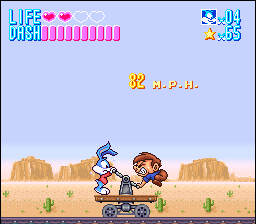 | 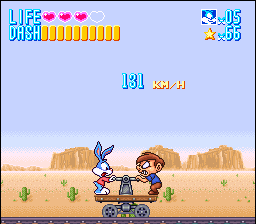 |
| North American version | Japanese version |
That makes sense and all – Japan doesn’t really use “miles” or “miles per hour”, so it’s understandable that it’d be converted. But this got me wondering: if it’s 140 kph in the Japanese game, is it also 140 kph in the Japanese movies?
Luckily, I have an old Japanese VHS copy of the original Back to the Future to check. So after fast-forwarding to the first time travel scene, here’s what we get:
Yep, it looks like the Japanese version of this Tiny Toons game matches the Japanese version of Back to the Future!
Given this, it’s possible that my Japanese VHS copy of Back to the Future doesn’t match what’s seen on more modern releases. Just thought I’d point it out in case it comes up at some point!
This game was released in other regions too, so I’m assuming that they all use the 140 kph version of this scene. If you can confirm this about your region, let me know – and let me know what your region’s version of Back to the Future handles the 88 mph thing too. I’m curious to see if some regions left it as-is while others converted it to kph.
If you liked this peek at Japanese references to American pop culture, check out my articles about Michael Jackson in Yakuza 0 and how they localized American movie references for Japanese Bubsy!



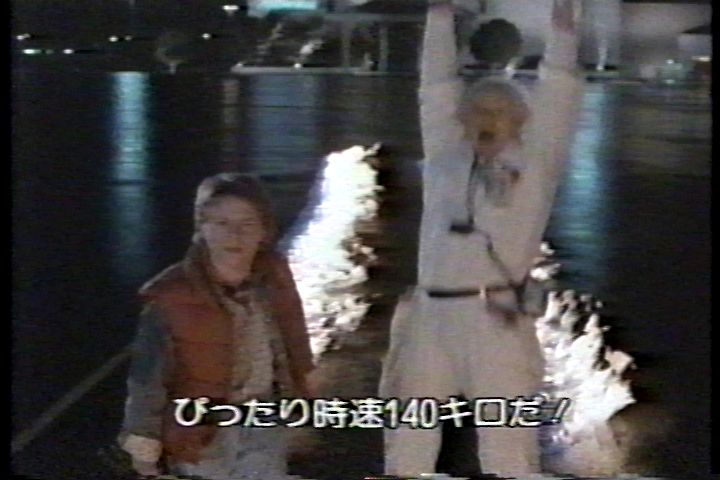
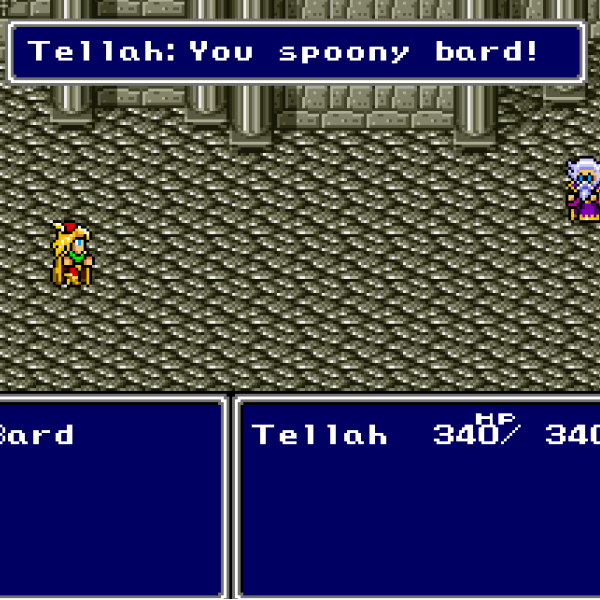


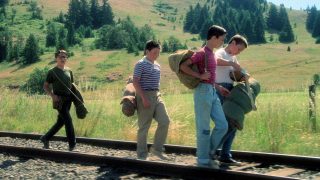
You also low key showed how Japan handled the line, “If my calculations are correct, when this baby hits 88 miles per hour, you’re going to see some serious shit.”
Haha, it’s always really interested to see how things like famous movie quotes end up in translation.
(…I’m actually writing a book about it – first time I’ve announced it anywhere!)
I’ve been thinking of writing more about movie stuff on the site, but I’ve been a little hesitant since I’m known mostly for looking at games. If people are cool with it though I could write more about the subject!
I’m cool as long as it’s classic movies, e.g., National Film Registry stuff.
I think movies will be fun, as it is still very relevant in the broader sense of localization, which is what your site is about. : ) The lessons learned can apply to video games and vice versa!
I’m definitely cool with you doing movie stuff, especially classic nerdy stuff like this. I remember you kinda talked about a few movies in those old AVGN articles when they dealt with movie-based games. Yeah, I’d love to see you talk about Japanese versions of a lot of those movies in that picture you posted.
I just want to note that I LOVED Flight of the Navigator as a kid. I have not been brave enough to rewatch it as a grown-up. Not sure I want my memories tarnished by the doubtlessly imperfect reality.
If anything, I think it has more meaning to me now as an adult. I can empathize with the grown-up little brother, so it adds a new dimension.
Personally, I have zero interest in movies, but don’t let me bring you down — if there’s one thing LOL has taught us over the years, it’s that there’s an audience out there for this sort of thing. 😉
The first localisation-thing in a movie that springs to mind is broccoli being changed to bell peppers in the Japanese version of Inside Out.
Okay, now I’m curious about something… how do the various releases handle Dr. Brown’s quirky pronunciation of gigawatt? I assume they just ignore it, but I hope they don’t.
In the Spanish dub (Latin America) the pronunciation sounds similar to the original, something like JIGOH-wátts. Always found it an odd word.
Many years later I realized they meant Giga!
Same in French! Also they changed 1.21 into 2.21, apparently for better lip-syncing.
In France, we also use km/h instead of mph, but the French dub of Back to the Future says “88 miles à l’heure” (=88mph). As for the game, I don’t think it has ever been translated into any language beside English, so it’s probably 88 mph in every region other than Japan.
Actually, doesn’t it seem incoherent when you hear “140km/h” while Doc’s device clearly displays “88mph”? It’s probably why they decided against converting it into km/h in the French dub.
Yeah, that’s exactly why I was wondering how it was handled in the Japanese version, since the speedometer clearly shows 88 all the time. The Japanese subs don’t really acknowledge the weirdness so I guess it’s assumed that audiences will figure out “oh it says a different number because it’s America”.
I assume that most Japanese kids have heard of the imperial system, then?
Most people around the world, kids included, have heard of all these various US-only measurement systems, they just have no idea exactly how much a “mile” or “inch” or “gallon” or “Fahrenheit” actually is.
If you stop some random American on the street and ask them if they know there’s a measurement called “Nautic mile”, they’ll probably say yes, but chances are they have no clue if a nautic mile is longer or shorter than a “normal” mile, let alone approximately how long it is.
There’s a Spain version.
This is interesting, though. I tried playing through the game… and it just skipped the entire train scene for some reason. O_o
Oh yeah, you have to play the game on a certain difficulty level to get certain stages to appear. I forget which one it needs to be to see the train but it’s probably normal or hard.
I was playing in Normal, but used a password. I started again and it loaded the stage. I’ll report back soonish.
I can confirm the Spanish translation uses 88 MPH.
That said, there’s a -lot- of other stuff that wasn’t touched… signs that say dash or jump, for example. They only touched the dialogue and instructions.
The Spanish version also fixes a bug present in all other versions: in the train cutscene in that stage, the game engine pushes the R Button specifically to dash, when it should push the buttons assigned to Dash (as it correctly does for the Jump button). So if you change R from its default, you can’t finish the level (on Normal or Hard, since Easy skips the entire section of the game).
Polish dubs of BttF also use 88 Miles instead of Kilometres.
Any consistency on whether stuff like this usually gets rounded in translation? Since 88 mph is actually 141 (and change) kph.
If numbers like that aren’t usually rounded then that seems like it might lean more towards the translator understanding the BttF reference and keeping it accordingly.
In general I tend to round myself, and in that recent FFVI comparison we saw a metric number converted to feet and then rounded up too.
It’s too bad they didn’t keep it at 141 though, as that’s an oddly specific number just as 88 is.
88 isn’t a round number in the first place, so I would imagine a translator that doesn’t get the reference would probably also produce an unrounded number. If BttF had used 90mph and the game had used 140kph then that would be evidence that the translator was rounding because the original was rounded.
But ninety is a DIFFERENT number in Back to the Future.
“Let’s see if you bastards can do ninety!” when the terrorists are chasing Marty before he goes forward to the past.
…
So how was that rendered? Somethin’ somethin’ kisama 145?
“Kisama 145” would be an awesome name for an anime metal band.
Interesting they rounded that down. To me “141” has more of an “88” feel to it than “140”— repeating and oddly specific digits.
If Japan doesn’t really use “miles per hour”, who gave Tails his full name?
For some reason I’m under the impression that the Sonic games had a lot of influence outside of Japan during development. I’m not sure if that was the case here though.
Sonic 2 was effectively American developed, though with leadership through employees effectively poached from Sega of Japan. The reason the character is called both “Tails” and “Miles Prower” stems from a disagreement between America’s Sega Technical Institute and Sega of Japan. All this stuff is in the Wikipedia article for further reading.
It dates even from the first game. Kalinke’s team made lots of changes to the original design for Sonic back when Sonic 1 was in development
Oh… oh my god. I never realized that was a pun name until just now.
I haven’t checked the game, but I just checked the German version of Back to the Future on Amazon Prime. There’s actually a difference between the Part I and III. In Back to the Future Part I, Doc Brown mentions “140 Sachen”, which would be a colloquial to say “140 km/h” in this context. But in Part III, he talks about “88 miles per hour”.
I wonder if that is due to the speed being such an important plot point in that movie, if they changed it because it is now the Old West and it might sound strange to have him talk to various engineers and so on and talk about kilometres, or if between the first and third movie there had been a change in how people wanted to localise the movies and they decided to stick more closely to the original measurements, for example.
It’s also possible that since 88 MPH became much more culturally relevant between the release of the original movie and the sequels, they figured going with 88 MPH made more sense.
Two different people directed the German dub. Andreas Pollak for Part 1 and Michael Nowka for Part 2 and 3. So that’s probably the reason for the difference.
And as you say in Part 3 the speed is a much more important plot factor, they constantly show the speedometer as a visual aid for the audience, so they probably figured that took precedent over consistency.
Little fun fact about the German translation of BttF.
The “flux capacitor” is translated as the “Fluxkompensator” when it should be correctly translated as “Fluxkondensator”. Why the change? No clue.
Maybe for easier lip sync, though theroetically there shouldn’t be much of a difference between Kompensator and Kondensator.
For the “multiple translations” thing: In Japan many movies until the late 90’s (I think) kept being redubbed for every single release. So most movies had:
-A first dub done for the cinema airings
-A second dub for the VHS release
-A third dub for TV airings (if different channels air that movie, there will be actually a single dub for each channel)
-And lastly a fourth (or more, see above) dub for the DVD release.
Later on they stopped doing this. 20th Century Fox actually noticed it and most of their older films in Japan got two different Blu-Ray release: A regular one that is just the one released everywhere and a deluxe “Emperor of Dubbing” release that features every single Japanese dub of that movie, plus a book featuring each dub’s script transcription to allow viewers to compare the different adaptations.
Don’t have much to add about the 88mph, but man did Konami produce some great licensed games back in the day. And as alluded to in the article, they frequently did a great job with including fun references for the fans… such as the obscure characters featured as minor enemies in the Spook Mansion stage, or how the stage theme for Sky-Jinks was based off a background track from the show (as was the boss theme I think? Not positive on that one).
Another example that comes to mind is the Simpsons arcade game. Considering the show was only in its second season at the time of the game’s release, it’s impressive how well Konami managed to capture the look and feel of the series, and how many cameos they squeezed in (not to mention that the original character designs for the henchmen and zombies capture the artistic style of the show remarkably well).
You have to play on Normal or Higher. I played through on Normal and saw every part of each level. Easy cuts out the bosses/chases.
I’ve heard that game features a further localization difference in that the Japanese version lets you use passwords at any difficulty, wheras I know English switches to Easy if you use a password (I never checked what happens if you use a stage 5 password, since stage is entirely omitted). Possibly it gave unlimited continues as well.
Konami did something similar on Babs’ Big Break on Game Boy, they removed the password feature and limited Continues for the west.
I don’t know about the game, but the movies do translate 88mph to kilometers
Silly me, I forgot to state I’m from Spain.
It seems the game does have an official Spanish translation. I’ll try and check into it
I did that already, it uses 88 MPH.
If I remember correctly, the Dutch subtitles on the movie also use 140 km/h. As for the game, it probably doesn’t even have a Dutch translation, given the era it was released in.
Speaking of which, the only games I know of that have Dutch translations are The Legend of Spyro series, and Breath of the Wild. I don’t know much about the former, but the latter only has the text translated, and no dub. Why is this?
I checked some later versions of BTTF here in Japan (The first film on Amazon Prime and Part III on Netflix) and the first film is identical to your VHS copy. Part III also keeps it at 140 kmh
I love the aesthetic of that first BttF VHS screenshot with the subtitles and everything.
Ever since it came out, Buster Busts Loose has been one of my favorite “nobody has ever heard of this even though it’s awesome” games. And of course, me being me, I ESPECIALLY love that they took actual background music cues from the TV series and recreated them with the Super NES soundfont.
I’m really happy about this article 🙂
Great game. Choosing Easy made you skip the football game too, which sucks since it is mildly entertaining and most people wouldn’t realize they missed a couple of stages until someone told them or they saw magazine screenshots.
Easy doesn’t skip tbe football level but it gives you the most time (you get the full 15 minutes to make one touchdown, versus I think 7 on normal and maybe like 3 on Hard). It is the sky level it skips, as well as most of the final level.
I think the confusion here might be from the fact that the British release of the game removes the level, since American Football has pretty much no following over here.
Guess I remembered wrong. My bad. It has been over two decades since I played it back in 1993.
One thing I do remember about the football level is the manual had a screenshot with a spelling error “BOLL ON”. (or maybe it was BOLE) I remember because I remember making the obligatory PhotoShop with everyone’s favorite game-based movie filmmaker. 😉
I recall the ingame text was, even in the Japanese version, spelled correctly.
Well, America clearly likes to do their own stuff so to speak. That aside, I might be able to recall some games where speed was indeed measured in miles in the english translations only with no way to change the units. The other translations likewise were hardcoded to Kilometres. Got any games in mind that might fit the bill aside from the example mentioned?
The Pokemon games give the Pokemon measurements in weird America-units in the English translations, and in normal sensible units in the original Japanese and all other translations.
“America units?” Isn’t it actually TV he British system, which even Britian doesn’t use anymore?
Most people call it the imperial system, but what empire does that refer to? The British?
Ah, there we are. This was going so nicely, I was starting to think I’d found the one place on the internet where you can mention imperial and metric and no one will get judgemental because America doesn’t use their silly french numbers. Thanks for bringing us down into the muck.
It’d probably help a lot if you stopped insisting on putting all these weird units into things that are getting released worldwide, you know. People don’t get grumpy because you use these units, they get grumpy because you force them onto others.
Right, because that’s what just happened. No, wait, it was you that started trying to force your silly french numbers on America after we bent over backwards to avoid you seeing a nice normal mile.
Metric numbers make a lot more sense, there’s no denying that. I say that as someone from the UK where we have largely transitioned over to metric, though not entirely, so I have a good experience of both. It seems weird you would come to a blog specifically interested in and even celebrating the differences between versions of games based on the regions they’re being made for, only to come and shit all over something that basically the entire rest of the world uses so you can go “USA! USA!”.
When the rest of the world can put a man on the moon, then they can claim their silly french numbers are good for something. Until then, empirical evidence indicates that feet, pounds, and gallons are OBJECTIVELY SUPERIOR.
And right now, literally everyone wanting to get off the Earth rides atop soviet-era leftovers to do it, so I don’t see this changing any time soon. But credit where due, the only way to put a man in space currently WAS built using Stalin’s favorite french numbers. (Speaking of american pride, it breaks my calloused nerd heart that NASA has been reduced to hitch-hiking on commie missiles.)
Also, I didn’t start this. I’m just happy to fire a few shots back when someone starts in on how someone else is using the wrong arbitrary measurement system.
And the reason is that people being so incredibly invested in a set of arbitrary numbers that they have to rant about the inherent stupidity of a different set of arbitrary numbers every time they see them amuses me.
Alsoalso: Rankine is the best temperature scale. Everyone is doing it wrong.
I really hope you’re joking.
I wish I was. The old Soyuz really is the only way to space.
Sorry, but that’s only partially correct. The computer used in Apollo missions used metric units (the international standard for science), but displayed United States customary units for the benefit of the astronauts.
The aerospace industry they were working with uses US measurements (and have no reason to change), and in NASA itself it varies depending on teams to this day (https://space.stackexchange.com/questions/37607/why-did-nasa-use-u-s-customary-units). They’re going metric for future moon landings though, for the sake of integration with other space programs.
…Anyway, you did make me look up the Rankine scale. Good job there.
I wish I could like comments on this website.
In Pokémon Ranger: Shadows of Almia, there’s a joke(?) where a character’s IQ and height in centimetres are the same. I guess using the metric system in American English makes you sound even more nerdy? (And the joke wouldn’t work if they converted it. I don’t know what it says in the original Japanese.)
Yeah, in America, metric measurements have a very “science-y” feel to them.
In the UK, we use Miles Per Hour (despite what America seams to think). So the game was still 88mph
This reminds me of two things in games which annoyed me to different extents. The first is minor, which is that Pokemon from day one had heights and weights in imperial in English no matter your country of purchase. Second one isn’t even a Japanese game, but GTA V, at least early on, has a GPS in miles which is sort of okay since the game is set in America and was mainly developed in the UK, but it switches to metric if you play it in any of the other *many* languages the game supports, but no option in English. Infuriating.
On the other hand, Rad Racer had the best localization. The US version changed the speedometer from km/h to MPH… well, it changed the label on it, but not the numbers. So 141 km/h = 141 MPH instead of 88 MPH.
Those were some fast cars, and more games need a Rad Racer mode.
Well, I don’t have anything in particular to add re: BttF, but I do have Endless Ocean: Blue World. The NA release uses feet for its depth while meters are used for other releases. This only causes a slight problem if you’re reading a FAQ written for a version that uses the other system, but it converts correctly, so…
Now I am curious. Did they literally made a new scene / shot with new dialog that says 140 kph? Or the dialog is still 88 mph and only the subtitle changes? I assume Japanese dub will also use 140 kph line but not sure if the English audio is also 140 kph?
Yeah, it’s just a subtitle change in the VHS copy I have, there’s no new/different content to accommodate for kph. Even when it shows the 88 on the dashboard thing there isn’t any extra info added via subtitles.
I can confirm that the Australian release of Back to the Future uses 88mph.